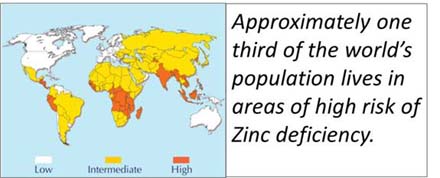 Zinc deficiency is a global health problem. In spite of proven benefits of adequate Zinc nutrition, approximately 2 billion people still remain at the risk of Zinc deficiency.
Zinc deficiency is a global health problem. In spite of proven benefits of adequate Zinc nutrition, approximately 2 billion people still remain at the risk of Zinc deficiency.
Zinc is supplied to the body through a diversified diet including meats, nuts, eggs, spinach, fish, mushrooms etc. which are seen to be inaccessible to people in developing countries. Children are especially vulnerable to Zinc deficiency which weakens their immune system making them prone to diarrhoea and pneumonia which are most common causes of death in developing countries. Surprisingly, India contributes to the largest child deaths in the world. Zinc deficiency also leads to retarded growth & development and stunting with life-long impacts on health, productivity and income.
According to Food and Health Organization (FAO), one third of the world population lives in countries that have high risk of Zinc deficiency, India being one of them. The most vulnerable are infants, young children, pregnant and lactating women due to their elevated requirements for Zinc.
Affordable approaches to eliminate Zinc deficiency exist and need to be implemented urgently. Zinc can be added to mineral pre-mixes used in fortification programs and preventive Zinc supplementation to be given to children of less than 5 years age in high risk countries. Exclusive breastfeeding during first six months to a child is an excellent source of Zinc. Also, by applying agricultural and food processing technologies, the amount of absorbable Zinc can be increased in staple foods. Point is we do understand that we need Zinc but how many of us actually demand it…